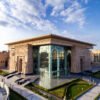Abu Simbel is one of Egypt’s most iconic archaeological sites. Moreover, it is renowned for its grandeur and has immense historical significance. Specifically, located near the border with Sudan, this temple complex is a masterpiece of ancient engineering and artistry. In fact, Pharaoh Ramses II built it in the 13th century BC. Furthermore, the site consists of two magnificent temples that honor both Ramses and the goddess Hathor.
The Great Temple of Ramses II

First, the Great Temple of Ramses II truly stands out. Notably, it features four colossal statues of Ramses II seated on his throne. In fact, each statue is about 20 meters high. This remarkable height showcases the pharaoh’s strength and divine status. As you approach, you will notice intricate carvings on the entrance. Moreover, these carvings depict scenes of Ramses’s military victories and his connection to the gods.
Interior Wonders

Once inside Abu Simbel, visitors can explore vast hallways and chambers. Each area is filled with detailed hieroglyphs and reliefs. Moreover, the inner sanctum houses statues of Ramses II and the gods Amun, Ra-Horakhty, and Ptah. Notably, on two days each year—February 22 and October 22—the sun shines directly on these statues. This alignment creates a spectacular sight and showcases ancient Egyptians’ understanding of astronomy and architecture.
The Temple of Hathor

Next, the smaller Temple of Hathor is adjacent to the Great Temple. Importantly, this temple is dedicated to Ramses II’s beloved wife, Nefertari. Additionally, it honors Hathor, the goddess of love, beauty, and motherhood. As you approach, the entrance features six statues—four of Ramses II and two of Nefertari—each about 10 meters high. Once inside, you will find beautiful reliefs depicting Hathor, along with scenes celebrating motherhood and fertility.
The Relocation Project of Abu Simbel Temples

In the 1960s, the construction of the Aswan High Dam threatened to submerge Abu Simbel under Lake Nasser. Therefore, to save this invaluable heritage site, UNESCO led an international effort to relocate the temples. Remarkably, this monumental project took four years. Specifically, it involved cutting the temples into large blocks and reassembling them at a new location. As a result, Abu Simbel now stands as a testament to human ingenuity and dedication to preserving history.
Visiting Abu Simbel

Visiting Abu Simbel is more than just a trip to a historical site. It offers an unforgettable experience that connects you to the ancient past. The temples are best accessed via a guided tour from Aswan. Many travelers choose to take a scenic boat ride on Lake Nasser. As you approach the site, the majesty of Abu Simbel unfolds against the desert landscape. This creates a stunning visual experience.
Conclusion
In summary, Abu Simbel is a remarkable wonder of ancient Egypt. It showcases the brilliance of Ramses II and the dedication of the Egyptian people. From its grand temples to its incredible preservation history, Abu Simbel continues to inspire awe. As you explore this magnificent site, you will witness the artistry of the past. Furthermore, you will feel a deep connection to the rich cultural heritage of Egypt.
At Odysseys Voyage, we invite you to discover the wonders of Egypt, including a visit to the awe-inspiring Abu Simbel. Explore our diverse range of Egypt tour packages to experience the magic of this incredible destination. Join us for an unforgettable journey through the heart of Egypt!




